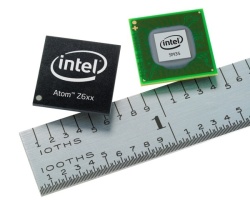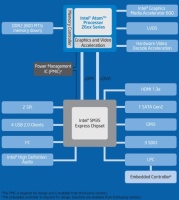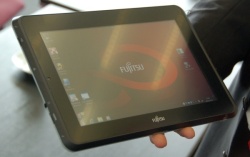Intel formally launches tablet Atom at IDF

![]() For an x86 processor, the Atom Z670 is both frugal and compact.
For an x86 processor, the Atom Z670 is both frugal and compact.
Source: Intel
Codenamed Oak Trail, Intel has developed a system-on-a-chip (SoC) including a single Atom core, a PowerVR SGX 535 graphics core, integrated DDR2 memory controller, and a Whitney Point Platform Controller Hub (PCH) to go with it. At the opening of its latest Intel Developer Forum, IDF 2011 in Beijing, it has now launched the two components under the product names Atom Z670 and SM35. The Z670 has a maximum clock speed of 1.5Â GHz â there is also a slower 1.2Â GHz Z650 version. Both should be suitable for non-fan cooled tablets or for netbooks.
The Atom Z670 boasts essentially the same technology as used in the Moorestown platform, aimed at smartphones, and the Atom E600 (Tunnel Creek), launched last autumn. In contrast to Moorestown systems, which use SFI code in place of a BIOS or UEFI firmware, Oak Trail is 'PC-compatible' â vendors can use any operating system they choose, ranging from Windows, Linux, Android or Chrome OS to MeeGo. Intel revealed that it is working with Google on bringing Android 3.0 to the platform but Intel executives would not say when devices using Android would be available. They did, though, say that they expected MeeGo based tablets would be available in the second half of the year alongside other operating system offerings.
Where the new offering differs from the embedded Atoms in the E600 series and the EG20T PCH is in the detail. At 1.5Â GHz and with a TDP of 3Â watts â including GPU and memory controller â the Atom Z670 is particularly frugal. According to Intel, it consumes an average of around 1Â watt. The SM35 PCH consumes at most an extra 0.75Â watts (EG20T 1.55Â watts) and also contains an upstream USB port to enable a tablet to be connected to a PC. In contrast to the US15W (Poulsbo) for Z500 Atoms, the SM35 also has a SATA port for a mass storage device.

![]() Block diagram of the Atom Z670 plus SM35
Block diagram of the Atom Z670 plus SM35
Source: Intel
As far as performance goes, the Atom has improved little over the last three years. The Atom Z670 contains the same 45 nanometre Bonnell core as the 1.6Â GHz Atom Z530 released in 2008. The PowerVR graphics core does now hit 400, rather than just 200Â MHz. The inbuilt HD video accelerator supports 1080p media and can output this via an HDMI 1.3a port.
The memory controller, by contrast, sees no improvement. The old Z500 Atoms had a 64-bit, 200 or 233Â MHZ (DDR2-400, DDR2-533) DDR2 interface. The new E600 and Z600 Atoms have just a 32-bit, but 400Â MHz (DDR2-800), DDR2 memory controller. The maximum possible 'Memory Down' â SDRAM chips soldered directly to the PCB â is 2Â GB. The SoC Atom is not designed for slotted) DIMMs or SO DIMMs, which are normally 64-bit. The maximum RAM data transfer rate of 3.2Â GB/s must be shared between the CPU and GPU.

![]() Fujitsu Stylistic Q550
In contrast to the AMD C-50 (dual core, 1 GHz, 9 watts TDP), with its integrated DirectX 11 Radeon HD 6250 GPU, the Atom Z670 does not offer hardware acceleration for Direct2D and DirectWrite under Windows 7, a feature used by some recent browsers. One reason for this is the lack of a WDDM 1.1 driver. After years of development, Intel's Embedded Media and Graphics Driver (EMGD) for the PowerVR SGX 535, aka. GMA 500/GMA 600, is still at the XPDM level. The EMGD should, however, support OpenGL ES 2.0 and OpenGL 2.0, meaning that WebGL acceleration should work.
Fujitsu Stylistic Q550
In contrast to the AMD C-50 (dual core, 1 GHz, 9 watts TDP), with its integrated DirectX 11 Radeon HD 6250 GPU, the Atom Z670 does not offer hardware acceleration for Direct2D and DirectWrite under Windows 7, a feature used by some recent browsers. One reason for this is the lack of a WDDM 1.1 driver. After years of development, Intel's Embedded Media and Graphics Driver (EMGD) for the PowerVR SGX 535, aka. GMA 500/GMA 600, is still at the XPDM level. The EMGD should, however, support OpenGL ES 2.0 and OpenGL 2.0, meaning that WebGL acceleration should work.
Intel is planning to showcase a number of tablets and netbooks containing the Atom Z670 at the IDF. Devices from Fujitsu (Stylistic Q550), Lenovo (IdeaPad Slate), Razer (Switchblade) and Samsung (Sliding PC 7) have previously been displayed.
(crve)
![Kernel Log: Coming in 3.10 (Part 3) [--] Infrastructure](/imgs/43/1/0/4/2/6/7/2/comingin310_4_kicker-4977194bfb0de0d7.png)

![Kernel Log: Coming in 3.10 (Part 3) [--] Infrastructure](/imgs/43/1/0/4/2/3/2/3/comingin310_3_kicker-151cd7b9e9660f05.png)
















